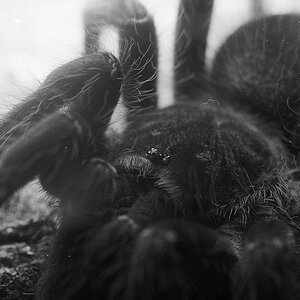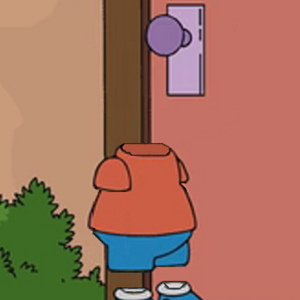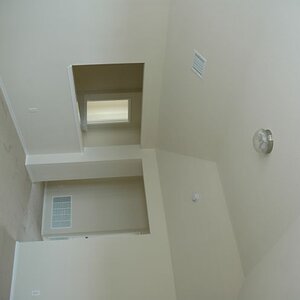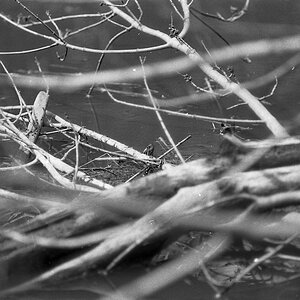Navigation
Install the app
How to install the app on iOS
Follow along with the video below to see how to install our site as a web app on your home screen.

Note: This feature currently requires accessing the site using the built-in Safari browser.
More options
You are using an out of date browser. It may not display this or other websites correctly.
You should upgrade or use an alternative browser.
You should upgrade or use an alternative browser.
Newbie: How to develop?
- Thread starter Deco
- Start date
Hello, and welcome to the forums. I moved your post to the darkroom forum because the regulars here can probably answer your question better.
oriecat
work in progress
- Joined
- Jul 7, 2003
- Messages
- 3,117
- Reaction score
- 19
- Location
- Portland OR USA
- Website
- www.moltenwords.net
Develop the film:
Edit - pre wash - fill and let it soak for a little bit, dump and refill if it comes out purpley
Developer - time will vary depending upon the film used and the developer used. Example, I generally use Ilford HP5+ 400 and it develops for 11 minutes in Rodinal at 1:50.
Stop bath - 30 seconds
Fixer - depends on the kind of fixer, rapid or non. I generally go 5-6 minutes just to be safe, even tho my rapid fix says it can between 2-4.
Fill and dump with water 3 times
Hypo-clear - 2 minutes
Wash for 10 minutes - edit - I think I only wash for 5 minutes here. Now I can't remember since I'm not doing it...
Swish in some PhotoFlo for a little bit. I don't time that part myself
Making a print:
Developer - After exposing in the enlarger, development times will vary. I usually do mine between 1.5 and 2 minutes.
Stop Bath - 30 seconds
Fixer - a couple minutes for RC paper, longer for FB. I don't usually time my fixing, I just leave it in for a while while I do other stuff.
Wash - 10 minutes for RC paper, 20 or 30? for FB
This is what I do anyway...
Edit - pre wash - fill and let it soak for a little bit, dump and refill if it comes out purpley
Developer - time will vary depending upon the film used and the developer used. Example, I generally use Ilford HP5+ 400 and it develops for 11 minutes in Rodinal at 1:50.
Stop bath - 30 seconds
Fixer - depends on the kind of fixer, rapid or non. I generally go 5-6 minutes just to be safe, even tho my rapid fix says it can between 2-4.
Fill and dump with water 3 times
Hypo-clear - 2 minutes
Wash for 10 minutes - edit - I think I only wash for 5 minutes here. Now I can't remember since I'm not doing it...
Swish in some PhotoFlo for a little bit. I don't time that part myself
Making a print:
Developer - After exposing in the enlarger, development times will vary. I usually do mine between 1.5 and 2 minutes.
Stop Bath - 30 seconds
Fixer - a couple minutes for RC paper, longer for FB. I don't usually time my fixing, I just leave it in for a while while I do other stuff.
Wash - 10 minutes for RC paper, 20 or 30? for FB
This is what I do anyway...
gecko
TPF Noob!
u use stop bath in your film developing?
oriecat
work in progress
- Joined
- Jul 7, 2003
- Messages
- 3,117
- Reaction score
- 19
- Location
- Portland OR USA
- Website
- www.moltenwords.net
yeah...
gecko
TPF Noob!
ookay
oriecat
work in progress
- Joined
- Jul 7, 2003
- Messages
- 3,117
- Reaction score
- 19
- Location
- Portland OR USA
- Website
- www.moltenwords.net
It's pretty standard practice...
gecko
TPF Noob!
i didnt say its wrong
maybe its a westcoast thing ;-)
maybe its a westcoast thing ;-)
rangefinder
TPF Noob!
Edit - pre wash - fill and let it soak for a little bit, dump and refill if it comes out purpley
The color that oriecat is referring to is the anti-halation backing on the film. Different manufactures may use a different color. Some are purple, red, blue and grey.
I always prewet a couple of times to ensure the anti-halation backing was removed.
I'm originally from the east coast. I always used stopbath.
The anti-halation backing was put on film to absorb light bouncing off the pressure plate. As light strikes the film it passes through the film, hits the pressure plate and is reflected back onto the film. The anti-halation backing absorbs this preventing the film from being exposed a second time.
ksmattfish
Now 100% DC - not as cool as I once was, but still
- Joined
- Aug 25, 2003
- Messages
- 7,019
- Reaction score
- 36
- Location
- Lawrence, KS
- Website
- www.henrypeach.com
- Can others edit my Photos
- Photos NOT OK to edit
Here's how I do it...
Film:
Load 35mm BW film on to reels and in to developing tank.
Make sure all solutions are at the same temp (68F is usually recommended).
Pre-wet (water): 30 sec constant agitation, thump the dev tank on the floor to dislodge air bubbles.
Developer: agitate for the first 15 sec, and then for 5 sec every 30 sec for the remaining time (varies with film, developer, etc...)
Stop Bath: 30 sec constant agitation
Fixer: agitate for at least 10 sec out of every 30 sec. Total fixing time is two times the clearing time. Clearing time is determined by dunking scrap film leader in fix and seeing how long it takes to completely clear (turn transparent).
Wash (water): 30 sec constant agitation
Hypo Clear or Wash Aid: 30 sec constant agitation
Wash (water): 30 sec constant agitation, empty and refill with fresh water, 30 sec constant agitation, repeat for a total of 5 or 6 times or 10 min in film washer
Photo-Flo: dunked in photo-flo, some minimal agitation
squeegee with fingers and hang to dry
Prints:
expose print
Developer: 1 min for RC and 2 min for FB, some agitation, I'll usually lift the print out of the developer once or twice
Stop: 10 to 15 sec, constant agitation
Fix: I follow the manufacturer's recommendations, 1 to 5 min depending on type of fixer and paper
Holding Bath (water)
Wash(water) RC: 10 min, squeegee on glass, lay on drying screen
Wash(water) FB: 60 min or 10 min in hypo clear, and 30 min wash, squeegee on glass, lay on drying screen
Stop Bath isn't absolutely necessary with film or prints, but besides halting the developing process, it extends the life of the fixer (which is typically one of the more expensive chems).
Film:
Load 35mm BW film on to reels and in to developing tank.
Make sure all solutions are at the same temp (68F is usually recommended).
Pre-wet (water): 30 sec constant agitation, thump the dev tank on the floor to dislodge air bubbles.
Developer: agitate for the first 15 sec, and then for 5 sec every 30 sec for the remaining time (varies with film, developer, etc...)
Stop Bath: 30 sec constant agitation
Fixer: agitate for at least 10 sec out of every 30 sec. Total fixing time is two times the clearing time. Clearing time is determined by dunking scrap film leader in fix and seeing how long it takes to completely clear (turn transparent).
Wash (water): 30 sec constant agitation
Hypo Clear or Wash Aid: 30 sec constant agitation
Wash (water): 30 sec constant agitation, empty and refill with fresh water, 30 sec constant agitation, repeat for a total of 5 or 6 times or 10 min in film washer
Photo-Flo: dunked in photo-flo, some minimal agitation
squeegee with fingers and hang to dry
Prints:
expose print
Developer: 1 min for RC and 2 min for FB, some agitation, I'll usually lift the print out of the developer once or twice
Stop: 10 to 15 sec, constant agitation
Fix: I follow the manufacturer's recommendations, 1 to 5 min depending on type of fixer and paper
Holding Bath (water)
Wash(water) RC: 10 min, squeegee on glass, lay on drying screen
Wash(water) FB: 60 min or 10 min in hypo clear, and 30 min wash, squeegee on glass, lay on drying screen
Stop Bath isn't absolutely necessary with film or prints, but besides halting the developing process, it extends the life of the fixer (which is typically one of the more expensive chems).
ksmattfish
Now 100% DC - not as cool as I once was, but still
- Joined
- Aug 25, 2003
- Messages
- 7,019
- Reaction score
- 36
- Location
- Lawrence, KS
- Website
- www.henrypeach.com
- Can others edit my Photos
- Photos NOT OK to edit
rangefinder said:The anti-halation backing was put on film to absorb light bouncing off the pressure plate. As light strikes the film it passes through the film, hits the pressure plate and is reflected back onto the film. The anti-halation backing absorbs this preventing the film from being exposed a second time.
It also keeps the whole roll of film from being fogged when light makes it through the felt trap on a 35mm cassette. Some IR films don't have the anti-halation coating, and that's why it's so important to handle them with care, as a little stray light can fog through the entire roll.
ksmattfish
Now 100% DC - not as cool as I once was, but still
- Joined
- Aug 25, 2003
- Messages
- 7,019
- Reaction score
- 36
- Location
- Lawrence, KS
- Website
- www.henrypeach.com
- Can others edit my Photos
- Photos NOT OK to edit
rangefinder said:I always prewet a couple of times to ensure the anti-halation backing was removed.
I also will usually rinse several times. I was taught to always pre-wet to help prevent air bells, and to "prime" the emultion for the developer, but I run into lots of folks who consider it completely unnecessary. I figure it doesn't really take that much extra time, and there is all that anti-halation gunk (Forte film rinse water stinks!!), and even if the problems it solves are rare then it's worth it.
Soulreaver
TPF Noob!
In the inside of cardbox the roll comes in theres a table that lists times and temperatures for the film/chemicals you are developing.
so you adjust the temperature of the mix (usually 20C) and use the time corresponding.So don't throw the cardbox away
so you adjust the temperature of the mix (usually 20C) and use the time corresponding.So don't throw the cardbox away

gecko
TPF Noob!
of course in theory after the first roll or so u kno wwhat times and such to use
oriecat
work in progress
- Joined
- Jul 7, 2003
- Messages
- 3,117
- Reaction score
- 19
- Location
- Portland OR USA
- Website
- www.moltenwords.net
... if you always use the same film.
Most reactions
-
 426
426 -
 294
294 -
 285
285 -
 272
272 -
 220
220 -
 204
204 -
 185
185 -
 181
181 -
 169
169 -
 167
167 -
 147
147 -
 133
133 -
 120
120 -
 95
95 -
I
94
Similar threads
- Replies
- 5
- Views
- 359
- Replies
- 17
- Views
- 1K

![[No title]](/data/xfmg/thumbnail/34/34148-864c8cb333c478b2dfb9e369908dc329.jpg?1619736320)
![[No title]](/data/xfmg/thumbnail/34/34052-c6933243940b9ae3474b0a2abaa08312.jpg?1619736253)


![[No title]](/data/xfmg/thumbnail/37/37535-0e9dcff8bc21e85b84fa89af160ac8d5.jpg?1619738132)
![[No title]](/data/xfmg/thumbnail/41/41757-2c3d7911242848ab00e3e9aaafa24381.jpg?1619739882)





